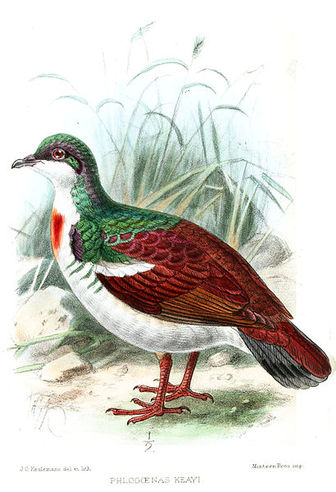Negros Bleeding-heart
This species has an extremely small, severely fragmented population. Continuing rates of forest loss on the two islands where it occurs suggest that it will continue to decline, thereby qualifying it as critically endangered.

The Negros Bleeding-heart is classified as Critically Endangered (CR), facing an extremely high risk of extinction in the wild.
The Negros Bleeding-heart (Gallicolumba keayi) is one of a number of species of ground doves in the genus Gallicolumba that are called "bleeding-hearts". They get this name from a splash of vivid red color at the center of their white breasts. The local name for this species is punalada. Like all bleeding-hearts, the Negros Bleeding-heart is endemic to the Philippines. This species has an extremely small, severely fragmented population. More
Negros Bleeding-heart also threatened with extinction - August 20, 2007 by Errol Gatumbato Negros Bleeding-heart Figure 1. The Negros Bleeding-heart. Aside from the elusive Negros Fruit dove (Ptilinopus arcanus), which has not been sighted since its first discovery in 1953, another species bearing the name Negros on its common name is a facing severe threat of extinction in the wild, and this is the Negros Bleeding-heart (Gallicolumba keayi). More
the Negros bleeding-heart having a narrower red patch on its white breast than other bleeding-hearts (2). It has dark chestnut upperparts with a reddish-purple gloss, creamy-buff underparts, and an iridescent green head and neck (4). It also has a noticeable greyish-white band across its folded wing (2). Range - Found only in the Philippines, on the islands of Negros and Panay (1). View a distribution map for this species at UNEP World Conservation Monitoring Centre. More
The scientific name of the Negros bleeding-heart hints at the behaviour of this bird. Galli means chicken and columba means pigeon, and this pigeon spends much of its time on the ground searching for food, like a chicken (6), only flying up into trees to roost, take cover or breed (7). Unfortunately, very little information exists regarding the diet and breeding behaviour of this bird, possibly due to its rarity. More
breeding programs, initially for Negros Bleeding-heart Pigeon (Gallicolumba keayi) in Negros but perhaps to include other species in other locations as may be appropriate and agreed by the Parties in the future; * To assist in the improvement of existing and/or development of new conservation centers and regional biodiversity programmes in the country, especially in West Visayas, Mindoro and Southern Luzon; * To promote and facilitate appropriate training for Filipino scientist and other local personnel on More
Family : Columbidae
Genus : Gallicolumba
Species : keayi
Authority : (Clarke, 1900)

